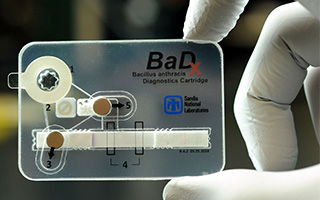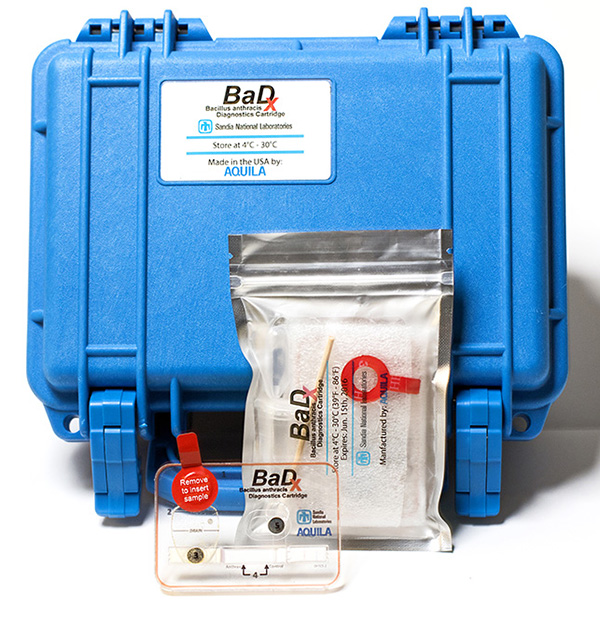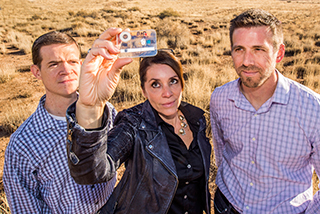
Anthrax is deadly and hard to detect. Sandia’s BaDx — a mini-lab the size of a credit card — makes it easier and cheaper to pinpoint the bacteria. With help from the labs’ technology transfer programs, BaDx is moving closer to market.
One of the world’s most common bacteria is also one of the deadliest. Bacillus anthraci, the bacteria that causes anthrax, is found in soils all over the world and can cause serious, often fatal, illness in humans and animals. It can survive in harsh conditions for decades, and people can be exposed through skin contact, inhalation of spores, or eating contaminated meat.

Detecting anthrax is challenging because samples for testing must be propagated in a laboratory that uses specialized tools requiring a consistent power supply, something often unavailable in the developing world. “Working with dangerous samples like B. anthracis spores places laboratory staff at risk,” says Melissa Finley (6825), a veterinarian and member of Sandia’s International Biological and Chemical Threat Reduction organization. “Concentrating many positive test samples in a lab could also tempt someone to steal positive anthrax samples for nefarious uses.”
Another barrier is cost. “Farmers in many developing countries don’t make a lot of money, so they don’t pay for diagnostic testing often,” Melissa says. “When they do, they can’t afford to pay a lot for it.” The most common diagnostic test for anthrax costs around $30, which is out of the reach of many farmers, perhaps discouraging them from testing animals they suspect are infected, Melissa says.
Sandia has developed a safer, easier, faster, and cheaper way to detect anthrax and is working with an Albuquerque company to commercialize the technology. Dubbed BaDx (Bacillus anthracis Diagnostics), the credit-card-size device, a mini-laboratory, can detect the anthrax bacteria in places with no power, refrigerated storage, or lab equipment. It could cost around $5-$7 and requires no specialized tools and minimal or no training.
“Farmers in many developing countries don’t make a lot of money, so they don’t pay for diagnostic testing often.”
The technology was licensed to Aquila, a New Mexico woman-owned small business that specializes in the design and manufacture of technologies and services for nuclear security and international safeguards. Aquila is working with Sandia through a Cooperative Research and Development Agreement to complete testing with external partners and begin marketing BaDx.
“This is a wonderful example of where sophisticated technology has enabled a practical solution to a very important problem,” says Mary Monson, senior manager of Technology Partnerships and Business Development Dept. 1180.
Complex and sensitive, but simple to operate
A Laboratory Directed Research and Development project launched in 2011 in Sandia’s International Biological Threat Reduction Program led to BaDx. While a large team helped develop the detector, the drivers were scientists Jason Harper (8631), Thayne Edwards, and Melissa.
BaDx needs no battery, electric power, or special lab equipment. It’s hardy against wide temperature variation and can detect very small numbers of B. anthracis spores. A field technician puts a sample swab into the amplification chamber, which contains selective growth media. The device then uses a lateral flow assay, similar to a common pregnancy test, to detect B. anthracis. Magnetically operated valves allow the sample to advance from stage to stage to complete the testing process. A colored line appears on the device several hours later if the test is positive for the bacteria.
The technician can then initiate a chemical process that sterilizes the device, avoiding the risk of positive samples accumulating and falling into the wrong hands. “The device amplifies the B. anthracis so it can detect as few as 100 spores instead of the typical 1-10 million required for detection,” Jason says.
Developed with commercialization in mind
BaDx builds on Sandia’s long-standing expertise in bioforensics, most visible in the work the Labs did in response to the anthrax spores mailed to media offices and two US senators in the fall of 2001, killing five.
Jason says BaDx was developed with commercialization in mind. “All the design considerations and performance standards were pointed toward marketing and getting BaDx out into the world,” he says.
“We set up meetings and brought the prototype. They liked it, and we were off and running.”
Thayne, who has since left Sandia, was working with Aquila on sensors through another Sandia tech transfer program, New Mexico Small Business Assistance, and mentioned BaDx. “We were about a year into the project and already had a prototype that demonstrated proof of concept,” Jason says. “We set up meetings and brought the prototype. They liked it, and we were off and running.”

Aquila was manufacturing within six months and is well into final external testing. “We see a lot of potential for government customers and nongovernmental organizations as well as commercial markets,” says Aquila’s chief scientist Markku Koskelo. The company anticipates future models of the device that will detect E. coli, salmonella, valley fever, and group A strep.
In 2015, BaDx was recognized by the Federal Laboratory Consortium with its national Award for Excellence in Technology Transfer. It also won an R&D100 Award in 2014, a TechConnect World 2015 National Innovation Award, and was named by Popular Science magazine as one of the greatest innovations of 2015.
“Aquila has been a great partner and its commercializing of this technology will help us fulfill our mission of serving the public good,” Mary says.